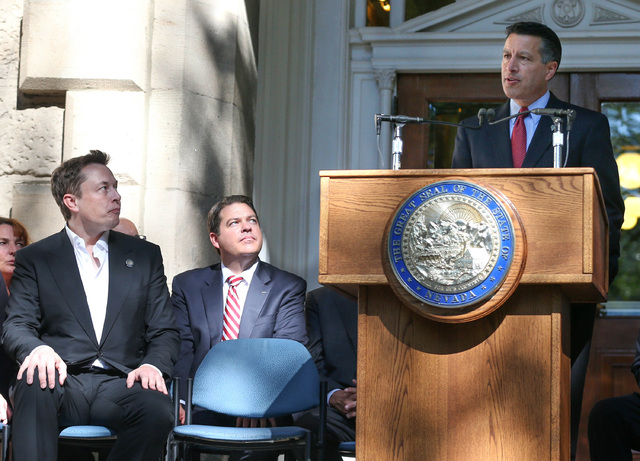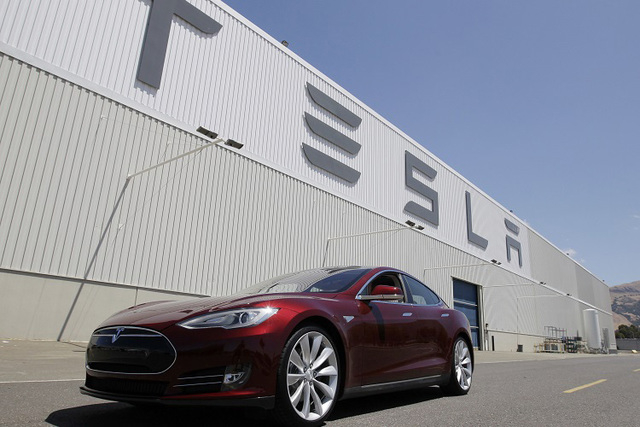Nevada’s share of Tesla plant could hit $1.3 billion












CARSON CITY — Gov. Brian Sandoval will ask state lawmakers next week to approve a deal to bring a Tesla battery plant to Nevada that will result in essentially no taxes being collected from the electric car manufacturer for nearly a decade.
In exchange for a package of tax breaks and credits that could reach $1.3 billion, the company would build its Gigafactory in Storey County east of Reno, bringing 6,500 high-paying jobs and a $5 billion near-term investment. Total investment is expected to reach $10 billion over time.
The state and local tax breaks could ultimately total $1.1 billion over 20 years, and tax credits $195 million.
The proposed incentives include sales and use and property tax breaks along with hiring and investment tax credits.
But Elon Musk, chairman and CEO of California-based Tesla Motors, said the incentive package offered by Nevada was not the most lucrative, nor was it the only reason to pick the state for the Gigafactory.
“What the people of Nevada created is a state where you can; where you are very agile, where you can do things quickly and get things done,” he said. “It’s a real get-things-done state. That was a very important part of the decision.”
Musk said the Gigafactory is a vital piece of the company’s plans to build a mass-market affordable electric car, which he said is projected for release in about three years.
“We’re going to build this awesome factory; it’s going to be something that is truly a wonder to behold,” he said. “The state is going to benefit to a huge degree. I don’t think there is anyone in Nevada who would regret this incentive package.”
Sandoval called the announcement a monumental decision that will change Nevada forever.
“Is this agreement good for us?” Sandoval asked. “I can answer that question today, without hesitation, and say emphatically that yes, this agreement meets the test.”
Information provided by the Governor’s Office of Economic Development to the Review-Journal on Thursday suggests the 5 million-square-foot battery plant will lead to the creation of another 16,000 indirect jobs in support of the project. The Wall Street Journal quoted the company as saying that the plant could someday be as large as 10 million square feet in size, bigger than any single factory in the U.S.
The construction component of the project, which is expected to gear up quickly, is expected to generate 3,000 jobs, the agency said.
SPECIAL SESSION
The incentive package will be considered by the Legislature in a special session expected to start Wednesday.
The Legislature will consider five bills, all involving the Tesla deal itself.
The governor’s office is not proposing any pork spending bill for Southern Nevada, which one legislator has suggested might be necessary to get support from that part of the state.
The special session could end by Sept. 12.
One figure on their minds will the project’s anticipated impact:
The factory will have an estimated $100 billion economic impact over 20 years, with $40 billion directly tied to the battery factory.
Over 20 years, because of the direct and indirect job creation, state and local tax collections are expected to total $1.9 billion after the abatements and incentives, more than offsetting the giveaways proposed to bring Tesla to Nevada, the agency reported.
The numbers come from two separate independent analyses provided to the state. The Tesla factory jobs are expected to pay $25 an hour on average.
“The real selling point is the opportunity it brings to the citizens of the state,” Steve Hill, executive director of the state economic development office, said of the proposal. “It is an agreement that all Nevadans can be proud of. But it had to make fiscal sense as well as economic sense.”
The factory would represent more than 20 percent of the regional gross domestic product once it is fully underway, according to the analyses.
As part of the deal, the state would also purchase the right of way needed to link Interstate 80 and U.S. Highway 50 to the south, encompassing the factory, at a cost of $43 million. This link would help Lyon County, with the highest unemployment rate in the state, participate in the jobs at the facility at the Reno-Tahoe Industrial Center where the plant will be located. Actual construction of the road would be an added cost.
For its part, Tesla would commit $7.5 million a year for five years to the state public education system as a way to help offset the impact of the workers on the local school districts. The company would also provide $1 million to the University of Nevada, Las Vegas for battery research.
And the various incentives are performance-based, requiring a $3.5 billion investment or the state would be able to “claw back” the giveaways.
There will also be a commitment to hire Nevadans and veterans for the Gigafactory jobs, although the details of such a proposal are still being hammered out.
A Democratic lawmaker familiar with the discussions said there will be a number of requirements before such a deal could be approved. They include a commitment to hiring Nevadans for the new jobs and guarantees that the state will benefit from the deal.
Top priorities for any deal are economic diversification, accountability, a return on investment and assurances of investment in exchange for tax breaks.
“All those benchmarks need to be in there,” the lawmaker said. “We’ve got to weigh the pros and cons. Until we see the details we can’t do that. We have to do our due diligence.”
TESLA DEAL APPLAUDED
The Nevada Assembly Caucus welcomed the move by Tesla.
“These are the kind of cutting edge, high-tech jobs and companies we want to attract to Nevada,” said Assembly Speaker Marilyn Kirkpatrick, D-North Las Vegas. “Democrats in the Legislature believe in order to continue attracting these kinds of jobs we have to take a bipartisan approach to finding a solution to adequately fund our schools and continuing to provide common-sense economic development plans.”
In a speech in Las Vegas on Thursday, U.S. Sen. Harry Reid hailed Tesla’s decision to build the battery factory in Nevada, and suggested that his annual National Clean Energy Summit might have had something to do with it.
“This is great news for Nevada, but it did not happen by accident,” the Nevada Democrat said during his opening remarks at this year’s summit at Mandalay Bay. “This is a perfect example of the partnerships between private industry and government forged here at the Clean Energy Summit.”
Reid went on to note that Tesla CEO Elon Musk was the keynote speaker at the summit in 2012, when he spoke about “the importance of innovation and investment in clean energy.”
“Now he is putting his words into action by announcing this critical investment in Nevada,” Reid said.
Sandoval also thanked Reid for helping bring Tesla to Nevada.
“I want to acknowledge his valuable support and his contribution into making today possible and making it happen,” Sandoval said. “He has been there every step of the way. This is a Nevada victory.”
There are skeptics, however, including the Nevada Policy Research Institute, which said Nevadans should be cautious about the proposed tax and incentive package.
“Why would lawmakers want to take from poor and middle-class families to subsidize a billionaire making cars for millionaires?” asked Geoffrey Lawrence, NPRI’s director of research and legislative affairs. “While advocates will predictably claim a public benefit for the subsidy in the form of greater unemployment opportunities, Nevadans should be careful to consider the trade-offs involved.”
OTHER DEAL DETAILS
Some of the details of the proposed tax breaks include:
There will be an elimination of all state and local sales and use taxes for the project through June 30, 2034. This break totals more than half of the total abatement and could reach $725 million. Included are materials purchased for the construction of the plant. The size of the tax break will depend on the value of purchases by the company over that period if time.
This part of the deal was required just to compete with other states seeking the plant, including Texas and Arizona, which do not impose sales and use taxes on manufacturing, according to the economic development office. The two states, along with California and New Mexico, were competing to win the plant.
There will also be a 100 percent abatement of the real property tax, the personal property tax and the modified business tax through June 30, 2024.
Two tax credits will also be offered worth $195 million, both which will be offset through existing state programs.
The first is a one-time $12,500 transferable tax credit per permanent full-time job on the site for up to 6,000 jobs worth $75 million.
The other is an investment credit worth 5 percent of the first $2 billion of investment, and 2.8 percent for the next $2.5 billion in investment for a total value of $120 million.
The programs will be paid for, if lawmakers approve, by reducing a current film tax credit program from $80 million to $10 million. The remainder will come from the elimination of a home office tax credit for companies that are based in Nevada. The more than 40-year-old program is used by a handful of companies at a cost of about $25 million a year. It will be sunsetted on Jan. 1, 2016, under the proposal, providing $25 million for five years for the Tesla deal.
A few remaining issues include a clarification of Nevada law that Tesla will be able to sell its cars in Nevada without a franchise agreement. There will also be a discount to the company’s energy bill for up to 25 megawatts of power. It is worth just under $2 million for the two years of the largest discount and a lesser amount for another four years.
Review-Journal writer Henry Brean and Stephens Washington Bureau writer Peter Urban contributed to this report. Contact Capital Bureau reporter Sean Whaley at swhaley@reviewjournal.com or 775-687-3900. Find him on Twitter: @seanw801.












